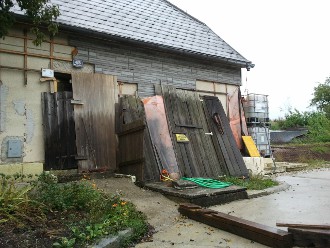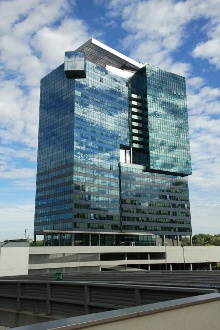Spreadsheet Monstrosities
 Markus used a gigantic spreadsheet to enter all parameters needed for such a calculation. It contained roughly 200 input parameters and 500 metrics for up to 50 product parts resulting in huge files with thousand of lines. Obviously Excel was reaching its limits and he needed something more powerful. We spent the first day discussing the domain of carbon footprint and created a small diagram defining the core elements of his calculations. Although we did not write any code it was a productive day because I helped Markus to reflect on his needs and he explained the requirement to me at the same time. We came to the shared conclusion that he needed a real database, but one that he might be able to develop himself, so we ended with Visual Basic (for Applications aka VBA) and MS Access. Although I did not fancy VBA it was the best choice for his needs and he liked the idea that he would be able to use parts of our VBA code in his spreadsheets as well.
Markus used a gigantic spreadsheet to enter all parameters needed for such a calculation. It contained roughly 200 input parameters and 500 metrics for up to 50 product parts resulting in huge files with thousand of lines. Obviously Excel was reaching its limits and he needed something more powerful. We spent the first day discussing the domain of carbon footprint and created a small diagram defining the core elements of his calculations. Although we did not write any code it was a productive day because I helped Markus to reflect on his needs and he explained the requirement to me at the same time. We came to the shared conclusion that he needed a real database, but one that he might be able to develop himself, so we ended with Visual Basic (for Applications aka VBA) and MS Access. Although I did not fancy VBA it was the best choice for his needs and he liked the idea that he would be able to use parts of our VBA code in his spreadsheets as well.Markus had used VBA some years ago and I had never worked with it before. It took us half of a day googling and reading StackOverflow until we got fluent and then we flew. VBA does not offer much and I missed a lot like unit testing, collection classes, closures and much more, still we made good progress. At the end of the second day, actually the very end of the day - it was 10pm, we had built full end-to-end functionality. Of course it was not finished and only calculated one simple formula of one metric for one product part without considering scenarios, different years or different customers. Still it showed the way. I had aimed for that because we needed to know if the chosen design would work. It looked good. During the third day we added more features Markus wanted to investigate, we even created an infix math parser to evaluate arbitrary formulas. It was great and I learned a lot.
Being Brutal
Back in Vienna I helped a small team of developers to improve their refactoring skills. The developers liked practice and I chose Adrian Bolboaca's Brutal Refactoring Game. I had participated in Adrian's session during XP2013 earlier this year and had liked it a lot. It is a programming challenge focusing on refactoring. The brutal part is that each code smell needs to be refactored right now, regardless how small it is. This makes an excellent exercise to train developers in spotting code smells and refactoring them. Adrian lists 17 code smells as the base of the game and I asked the team to prepare short presentations about each of them. At the beginning of the session the developers presented the material to the audience. I just love when trainees teach themselves ;-) During the sessions I collected all the smells I had flagged. Half of them was about naming, i.e. "name not from domain" and "name not revealing intent" which did not surprise me because naming is a difficult problem. Further 30% were "Primitive Obsession" and "lack of tests", common problems in most code bases. One participant was disappointed that he did not hit each of the 17 smells at some point during the game - maybe I will add some game like achievements for completionists like him.
Even for a small group it was demanding to watch out for the smallest code smell in several evolving code bases at the same time. I noticed that pairs kept hitting the same smells again and again. Besides naming, which all participants had to deal with, one pair was "obsessed with primitives" several times, whereas another team had trouble writing tests to cover their design ideas. A fast typing pair, two developers who knew their IDEs well, created a lot of code, but as soon as I found a smell they were unable to remove it by refactoring and had to delete the new code and start over. Although I was as brutal as possible and challenged the participants a lot, I got positive feedback after the exercise and all participants learned something.
 The Java User Groups of Austria
The Java User Groups of AustriaFor the rest of the week I went "on tour" with the Java Klassentreffen 2013. The Klassentreffen is a series of events organized by the Austrian Java training company Ciit and sponsored by Oracle. It is a mixture of sales pitches and technical presentations, covering various aspects of Java. Technically the Klassentreffen did not meet my requirements for the pair programming tour, but the organizers had invited me to speak and food was provided. Together with Martin Ahrer, the founder of the eJUG Austria, I introduced the audience to Java and Java related user groups in Austria. I started my talk with the reasons to attend user groups, then covered the core groups of Java, Eclipse, Android and Scala and finished the presentation with Open Source, Software Craftsmanship and upcoming Code Retreats. (For details and links please open the slides.) Later the leaders of several groups told me about new registrations, so I guess my presentation was a full success.
 Culture Shock
Culture Shock





















